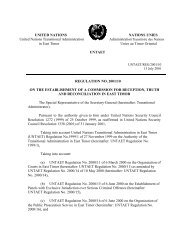The Srebrenica Massacre - Nova Srpska Politicka Misao
The Srebrenica Massacre - Nova Srpska Politicka Misao
The Srebrenica Massacre - Nova Srpska Politicka Misao
You also want an ePaper? Increase the reach of your titles
YUMPU automatically turns print PDFs into web optimized ePapers that Google loves.
UN Report on <strong>Srebrenica</strong>—A Distorted Picture of Events<br />
Muslim agents against their own people. 5 Also well after <strong>Srebrenica</strong>,<br />
Operation Storm, by far the single largest ethnic cleansing campaign of<br />
the Balkan wars, was carried out jointly by the U.S.-trained armies of<br />
Croatia and Bosnia against the Serb inhabitants of the Krajina region<br />
(see below), making it clear not only that not all “deliberate and systematic<br />
attempt[s] to terrorize, expel or murder” would be countered by<br />
NATO, but that in certain cases they would be aided and abetted by<br />
NATO.<br />
Thus, in reality, NATO’s use of “punishing force against the Bosnian<br />
Serbs,” as the New York Times described the operation, 6 was undertaken<br />
to show both the Bosnian Serbs and the rest of the world that NATO<br />
had taken sides in these wars, and to compel the surrender of the Serbs<br />
of Bosnia as well as Croatia—not only a far cry from the humanitarian<br />
motive trumpeted by the UN report, but in fact its negation. Although<br />
U.S. and NATO-bloc planners had used humanitarian rhetoric in early<br />
1999 when launching their 78-day war against the Federal Republic of<br />
Yugoslavia and in support of rebel Kosovo Albanian forces, and though<br />
this war violated both the UN Charter and international law, causing yet<br />
another massive humanitarian crisis in the region, 7 it was for the sake of<br />
legitimating more wars like it that the political project behind <strong>The</strong> Fall<br />
of <strong>Srebrenica</strong> must be understood.<br />
Because this UN report was published more than four years after the<br />
events of July 1995, it could have benefited from a range of articles and<br />
books by well-placed individuals inside and outside the UN who had<br />
challenged the official view that portrayed the Bosnian Muslims and<br />
Croats as innocent victims, and Serbs as aggressors in a region they have<br />
inhabited since the seventh century. <strong>The</strong> writings of UN Commanders<br />
General Philippe Morillon of France, General Lewis MacKenzie of<br />
Canada, and General Sir Michael Rose of Great Britain, offer far more<br />
knowledgeable and balanced accounts of the actions of the warring sides<br />
than the author of <strong>The</strong> Fall of <strong>Srebrenica</strong>. In a war where brutality by<br />
all sides is well documented elsewhere, the UN report misses few opportunities<br />
to downplay abuses by Bosnian Croats and Muslims, or to<br />
endorse highly inflated reports of abuses by Bosnian Serbs.<br />
<strong>The</strong> list of those interviewed for the UN report 8 includes Bianca Jagger,<br />
a former rock star wife turned celebrity activist, but does not include<br />
Deputy NATO Commander U.S. General Charles Boyd, whose role as<br />
225



